AI in Business Process Automation

At first glance, artificial intelligence (AI) and automation might appear like a match made in heaven. Integrating AI and machine learning into your business operations can streamline processes, enhance efficiency, minimize errors, optimize resource usage, and ultimately boost business outcomes. And who wouldn't want that?
With global economic challenges putting immense pressure on businesses to streamline operations, cut costs, and stay competitive, artificial intelligence automation offers a solution. By simplifying time-intensive tasks and enabling data-driven decisions, it might be the upgrade we've been waiting for so long. Let's unveil the benefits that recent AI/ML developments can bring to business processes.
Limitations of Current Business Process Automation Software
Business automation, often referred to as business process automation (BPA), uses technology to streamline repetitive and manual tasks within operational workflows. The primary objective of BPA is to enhance productivity by minimizing human intervention in repetitive processes. This approach delivers significant benefits, including improved efficiency, fewer errors, and faster workflows.
Common applications of BPA include tasks like
- data entry
- invoicing
- order processing
- employee onboarding
- customer service, etc.
Automation systems have traditionally relied on rigid logic, such as predefined if-then workflows, rules-based engines, and templated actions, to carry out repetitive and predictable tasks. While these systems are effective in managing uniform processes, they often falter when faced with variability, unexpected scenarios, or ambiguous data.
Robotic Process Automation (RPA) refers to a Microsoft-driven technology that leverages software robots to replicate predefined human actions when interacting with various computer systems to accomplish business tasks. For example, in the financial services sector, RPA has been deployed for data entry, account reconciliation, and remote transactions. A key advantage of traditional RPA is its ability to improve efficiency. It operates consistently regardless of external factors while also delivering rapid processing speeds.
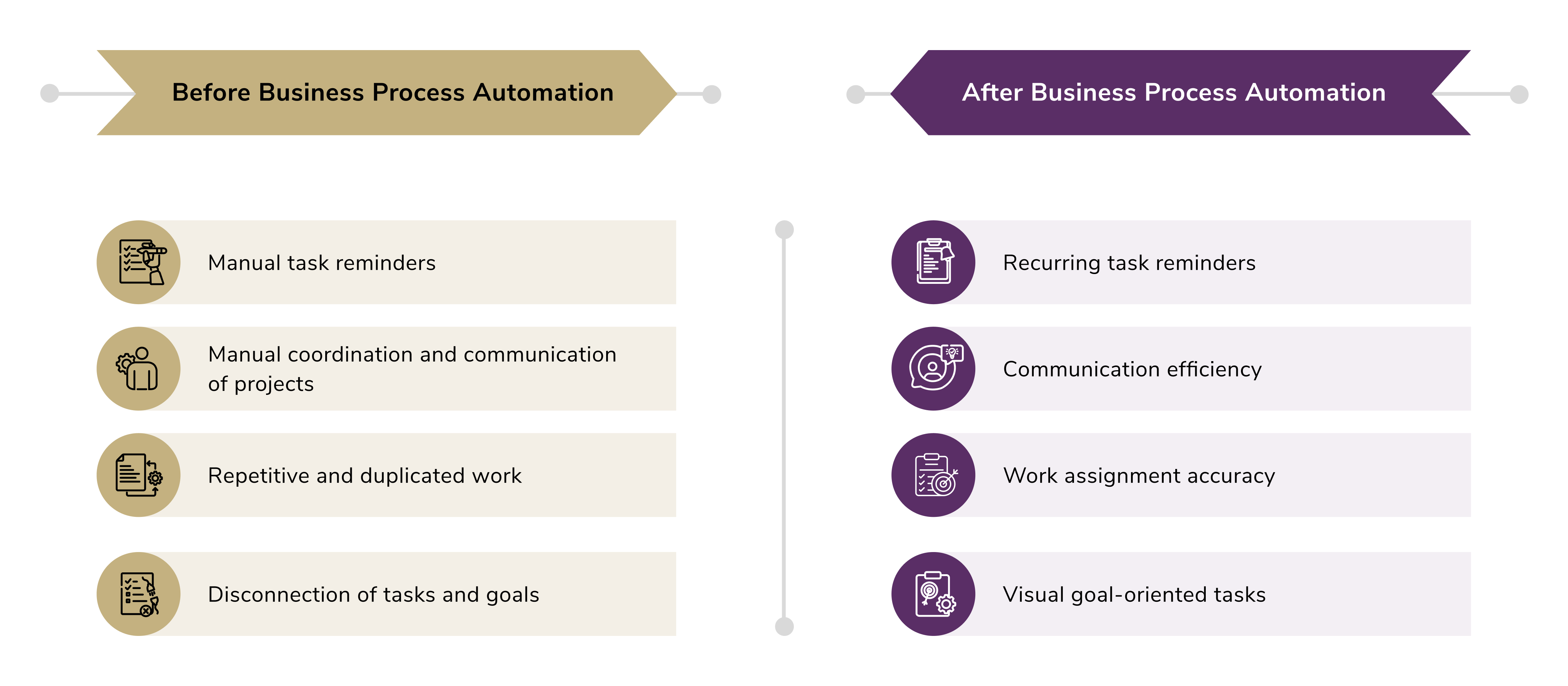
Additionally, RPA is relatively non-intrusive. It functions at the presentation layer, allowing robots to interact without requiring insight into how systems are implemented. This means they can be deployed faster compared to many other automation tools.
However, RPA is not without limitations. It struggles with scenarios involving unstructured text, such as information in emails or scanned documents, limiting its applicability to more complex use cases. RPA also lacks the capability to learn autonomously. It requires programming for every new process or exception, making it challenging to adapt or maintain when business processes change.
Scaling RPA across an organization introduces additional challenges. As bots take on more autonomous functions, the complexity of coordinating and monitoring them increases, requiring heightened supervision to manage these processes effectively. Another limitation is the lack of cognitive functionality. RPA tools cannot analyze context or exercise judgment, excluding tasks that require reasoning or decision-making.

There are also security and compliance considerations that accompany RPA implementation. Because bots can access sensitive account information and execute intensive operations, ensuring adherence to security standards and regulatory compliance is critical. If poorly managed, these risks could undermine the potential benefits of automation.
Business Process Automation Market
The BPA market is projected to generate $41.8 billion by 2033, reflecting a compound annual growth rate (CAGR) of 11.8% over the forecast period (2023–2033). Currently, business process automation software contributes approximately 35% to the total revenue of the global BPM market.
An entire industry is now evolving around the fusion of artificial intelligence and automation, termed Intelligent Process Automation (IPA). With a projected compound annual growth rate (CAGR) exceeding 13%, the IPA market is anticipated to reach a valuation of approximately $37 billion by 2030.
IPA represents the convergence of AI with conventional automation methodologies, enabling businesses to go beyond automating repetitive and routine tasks. Unlike static automation systems, IPA has the capability to learn, adjust, and enhance its performance over time, essentially demonstrating self-directed problem-solving. This makes it an advancement over RPA, which is confined to executing pre-defined tasks without the ability to reason or improve autonomously.
Why Business Processes Need AI
Organizations are leveraging AI process automation in numerous impactful ways. Let us highlight the most important one:
- Enhanced capabilities to build, test, and orchestrate business workflows at a faster pace.
- Learning from operational data to provide actionable recommendations and establish best practices (Predictive AI).
- Automatically identifying API specifications and developing the required connectors, expediting application development and deployment (Assistive AI).
- Transforming developer concepts into Business Process Model Notation (BPMN) and Decision Model and Notation (DMN), while also generating test data to ensure application code performs efficiently (Generative AI).
Note: By 2027, generative AI (GenAI) tools are expected to play a pivotal role in analyzing legacy business applications and generating suitable replacements, which could cut modernization expenses by up to 70%. According to Daryl Plummer, Distinguished VP Analyst at Gartner, advancements in large language models (LLMs) present CIOs with an overdue and credible method for reducing the costs of modernizing outdated systems. CIOs are encouraged to establish dedicated testing units to assess outputs generated by GenAI LLMs. Additionally, implementing change management strategies and workforce upskilling plans will be essential to achieving maximum productivity during the modernization process.
Companies leverage Intelligent process automation as an endpoint by
- using AI/ML technologies as standalone steps in workflows, within broader process orchestration, or through third-party connector services
- utilizing AI's contextual awareness and decision-making capabilities to optimize workflow automation and assign tasks accurately to the appropriate systems or personnel.
Here's a quick rundown of major AI technology trends in BPA:
- Hyperautomation with AI and RPA (Robotic Process Automation).
- AI-driven workflow optimization and decision-making.
- Natural Language Processing (NLP) for document processing and chatbots.
Intelligent Automation vs. AI Process Automation
Automation, as it is understood today, primarily refers to AI integration. AI bridges the gap between humans and machines by enabling machines to perform tasks traditionally considered exclusive to humans (learning, reasoning, and problem-solving). Incorporating AI into automated systems enhances their complexity and versatility compared to traditional, rule-based automation. Erik Brynjolfsson and Andrew McAfee highlighted back in 2014 how AI is propelling society into a "Second Machine Age," delivering unprecedented efficiency through digital tools. They emphasized that AI-equipped automation can
- process and analyze intricate tasks
- handle unstructured big data
- make instant, informed decisions unattainable with conventional systems.
Intelligent Automation (IA) represents an advanced evolution in the field of automation, blending AI with RPA to address more complex and cognitive tasks. By integrating AI capabilities like ML, Natural Language Processing (NLP), and cognitive automation, IA surpasses traditional rule-based automation systems.
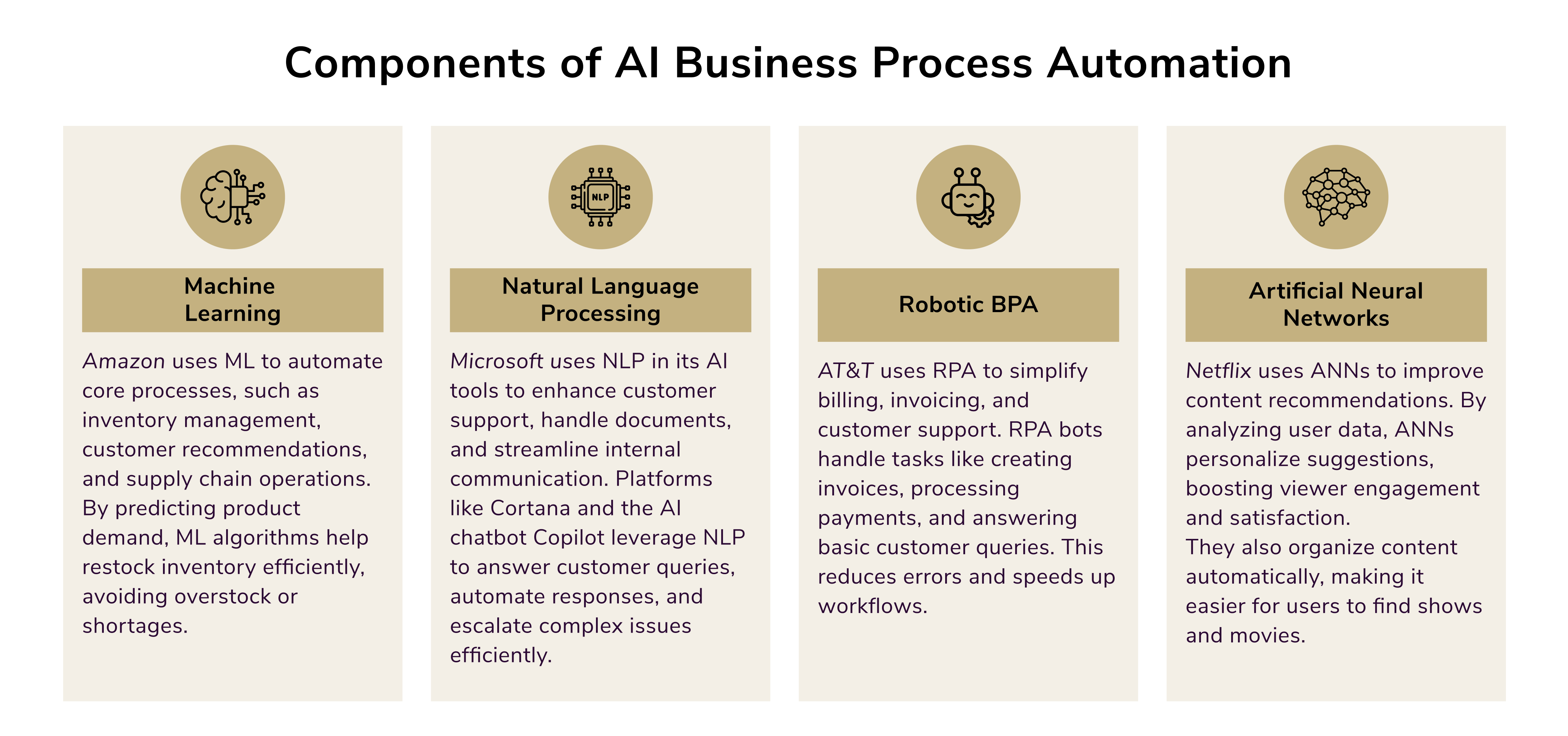
A clear distinction exists between AI process automation and Intelligent automation. AI process automation enhances traditional process automation by incorporating artificial intelligence. This enables the automation of more complex processes and decision-making tasks, delivering even higher levels of efficiency. Intelligent automation (also known as intelligent process automation) represents a more advanced approach, combining
- AI-driven automation
- robotics
- advanced analytics
- deep learning.
These systems are designed to autonomously analyze intricate systems, make decisions, adapt to changes, and continually learn. Intelligent automation operates effectively at an enterprise scale, requiring minimal human intervention.
Process intelligence
Process intelligence is the foundational enabler of generative AI-based automation in enterprises. It provides large language models (LLMs) with critical contextual insights to understand how businesses function across systems, departments, and regions.
By merging data from advanced technologies like process mining with standardized process knowledge honed through years of optimization expertise, process intelligence enables AI to gain a comprehensive understanding of end-to-end business processes. This contextual awareness empowers AI to align with business needs and drive more effective and adaptive process automation.
Note: without the crucial context provided by process intelligence, combining AI and automation can present significant risks. Even the most advanced machine learning models risk automating inefficient processes if they rely on inaccurate or incomplete data. Additionally, without a holistic understanding of operations, automating one segment of the workflow might lead to unintended and disruptive consequences in other parts of the organization.
Use Cases of AI in Business Automation
One of the most efficient ways to comprehend process optimization via AI is to learn from real-world use cases. Let’s take a look at AI automation examples so far delivering magnifying results.
Research and Development
Traditional R&D processes often involve the collection of vast amounts of data, which can be cumbersome and time-consuming to analyze manually. AI algorithms, particularly machine learning models, excel at processing large datasets, identifying patterns, and deriving insights that can inform decision-making. For example, AI can sift through historical research data to predict outcomes or optimize experimental designs, effectively shortening the research cycle.
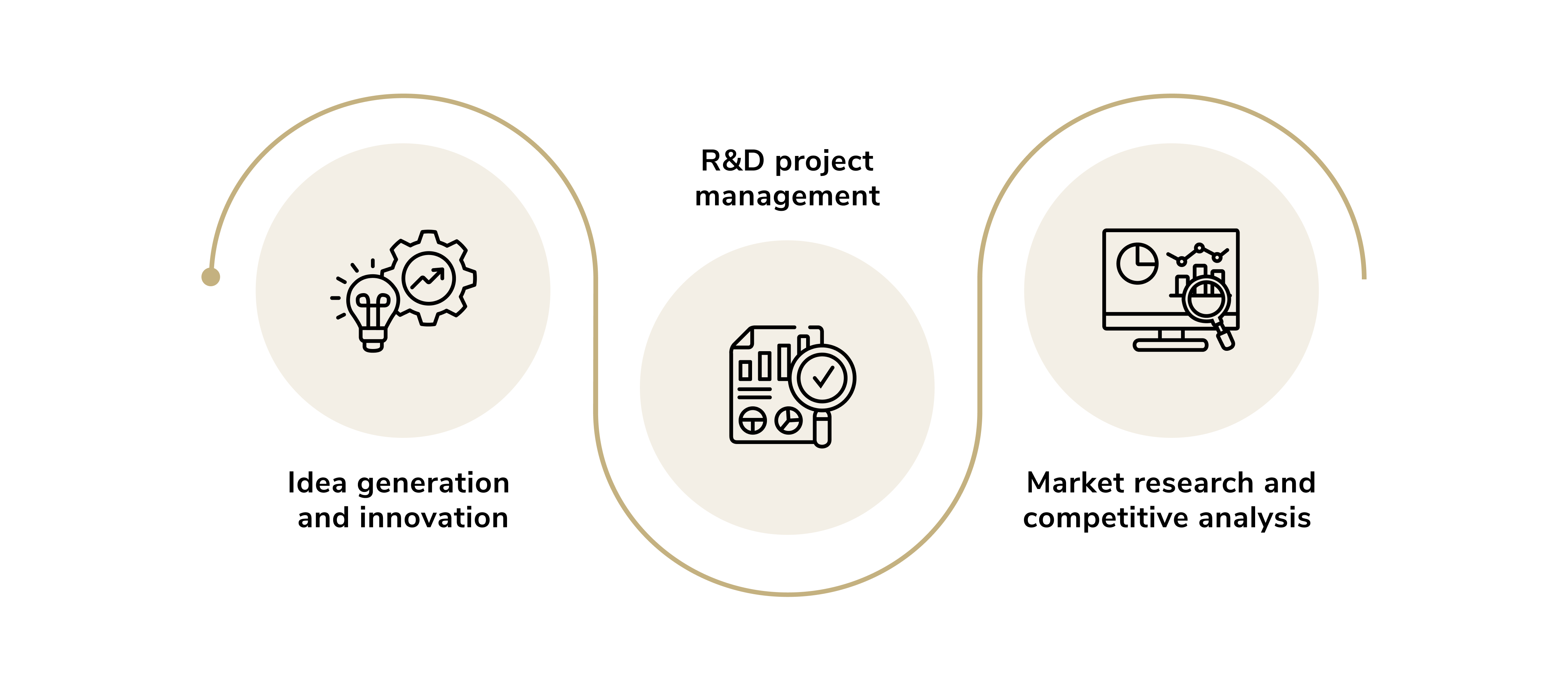
A great example is Siemens. The company has integrated advanced AI algorithms into its product development processes, particularly in the fields of energy management and industrial automation. For instance, the company utilizes AI-enhanced simulation tools to design and test new technologies in a virtual environment before physical prototypes are created. This approach not only reduces development time but also minimizes resource expenditures on materials and labor.
Siemens has also initiated projects that utilize AI for predictive maintenance in manufacturing equipment. By analyzing operational data, AI models can predict when machinery is likely to fail, allowing Siemens to innovate in creating more durable products. This predictive capability not only improves the efficiency of research but also enhances product reliability, ultimately leading to higher customer satisfaction.
Siemens has also made strides in developing intelligent digital twins—virtual representations of physical assets that are updated in real-time with data. This technology allows their R&D teams to simulate various operating conditions and stress-test new designs, facilitating rapid iterations and informed decision-making.
Recruitment and HR
HR departments can maximize efficiency by incorporating AI to handle repetitive and time-intensive tasks such as screening candidates, scheduling interviews, and maintaining employee records. HR teams can thus shift their focus to strategic initiatives, including talent management and fostering employee engagement.
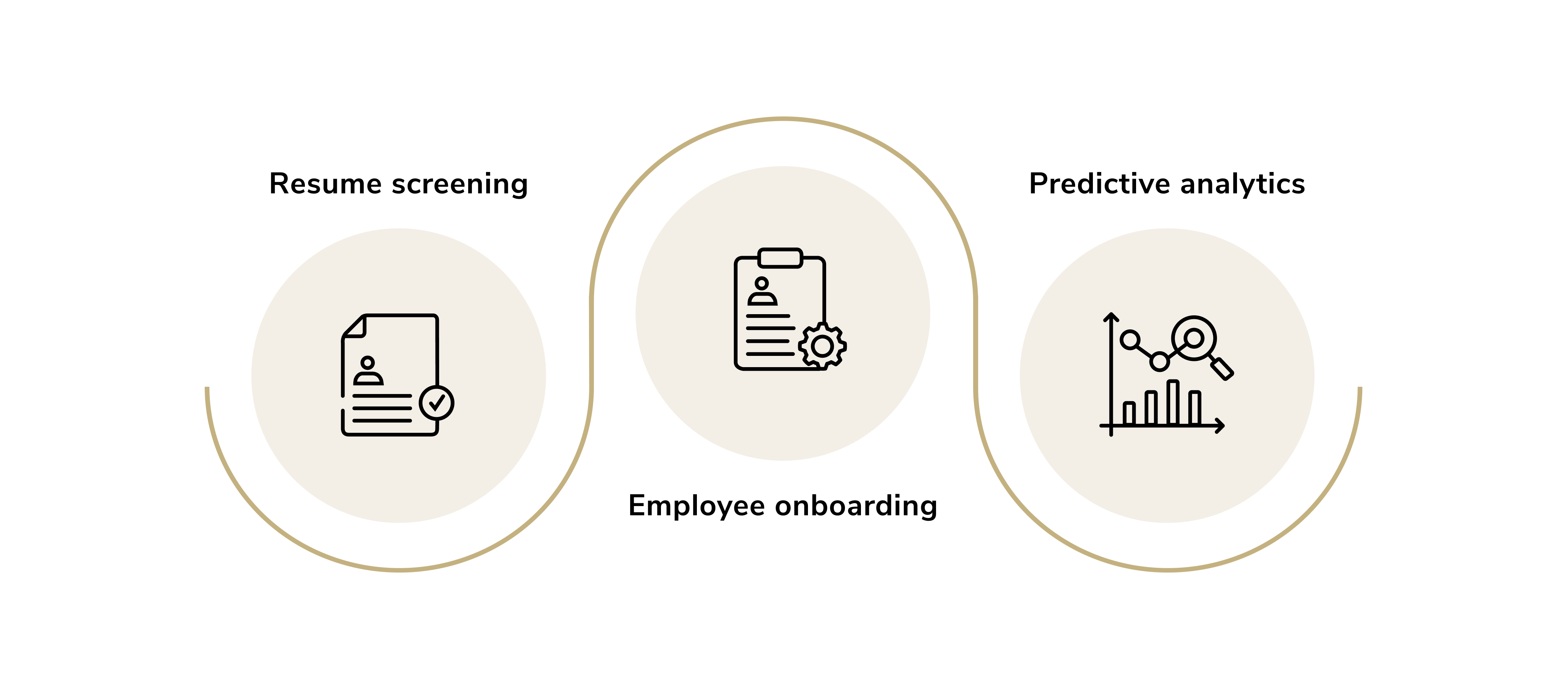
Unilever, a globally recognized consumer goods company, has successfully integrated AI-driven solutions like Pymetrics and HireVue into its hiring processes. Pymetrics leverages AI to assess applicants' cognitive and emotional attributes, while HireVue employs video analysis to evaluate candidates' compatibility with specific roles.
Unilever's implementation of AI for resume filtering has streamlined candidate selection by accurately identifying top talent in record time. These advancements have significantly reduced recruitment timelines and enhanced the alignment between candidates and job roles. By utilizing AI, Unilever has not only improved the efficiency of its hiring processes but also raised the overall effectiveness and outcomes of its recruitment strategies.
Invoice Processing
Manual invoice processing can be tedious, inconsistent, and prone to errors, especially for organizations managing vast volumes of transactions spanning multiple suppliers, currencies, and formats. AI helps mitigate these challenges by automating tasks such as document classification, field extraction, and exception handling.
One practical implementation involves utilizing computer vision to extract details like line items and payment terms from scanned invoices. Natural language processing (NLP) models can then cross-verify the extracted information with purchase orders and contractual agreements. Any discrepancies, such as duplicate entries or mismatched amounts, are automatically flagged. Additionally, payment approvals are routed according to predefined business logic. This approach allows finance teams to reduce processing time, enhance accuracy, and minimize penalties for late payments.
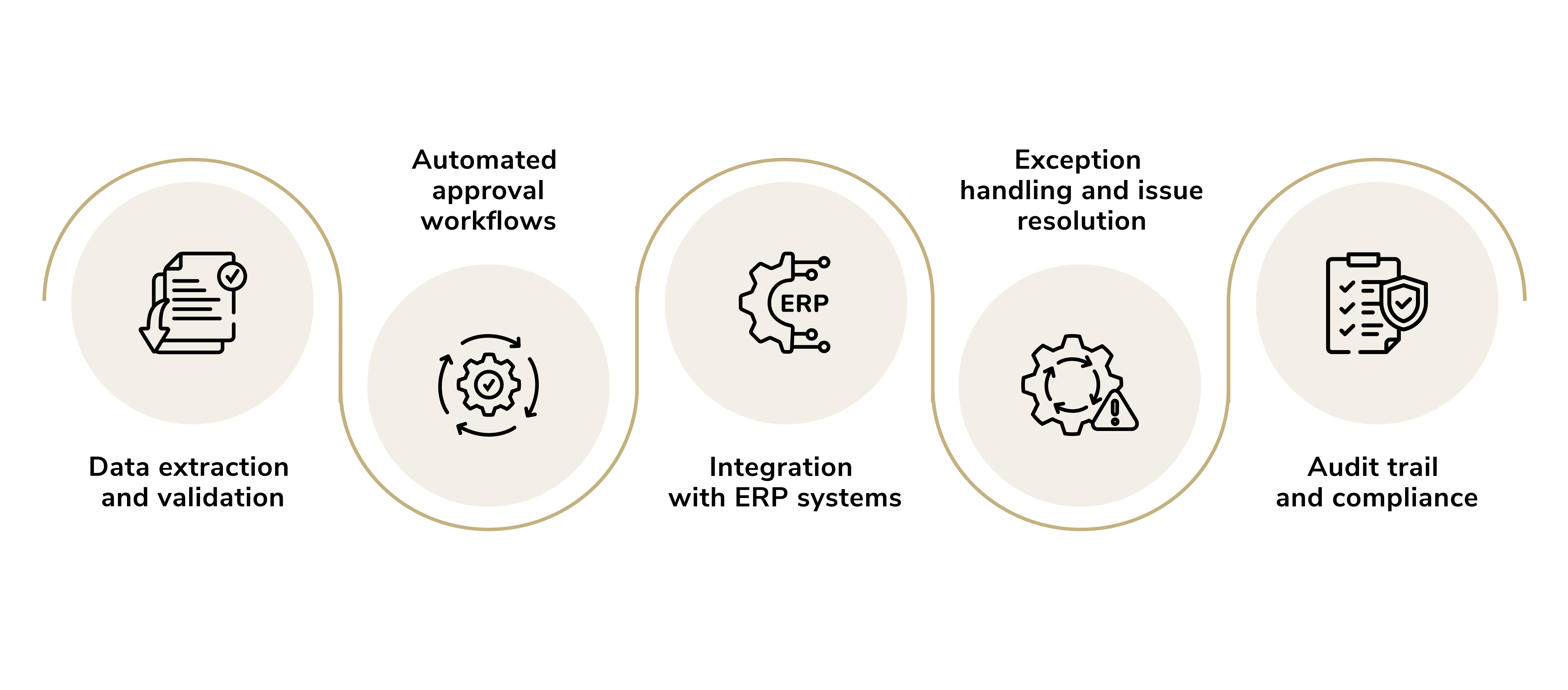
BlueSnap provides a comprehensive payment processing platform that includes invoice management powered by AI. The platform automates the matching of invoices to purchase orders, allowing companies to ensure that they pay only for goods and services they have received. This not only enhances cash management but also improves supplier relationships through timely and accurate payments.
Xero, an online accounting software provider, employs AI features to help its small business clients automate invoice processing. The system allows users to scan invoices and automatically extracts relevant information for effortless entry into their accounting ledger. This functionality is particularly beneficial for small businesses that may lack adequate staffing for managing invoice workflows.
Purchase Orders
Disjointed systems, manual approvals, and error-prone handoffs across teams often hinder procurement processes. With intelligent automation, organizations can streamline the entire procurement cycle. This involves extracting data from purchase requisitions, validating it against budget constraints, and initiating workflows that align with company policies.
For instance, intelligent automation tools can assess vendor compliance, highlight discrepancies in pricing by comparing them to historical purchases, and dynamically trigger approval chains based on spending thresholds and cost center allocations. When combined with RPA and enterprise resource planning (ERP) systems, AI-driven business process management enhances efficiency, promotes adherence to policies, and significantly reduces procurement cycle times.
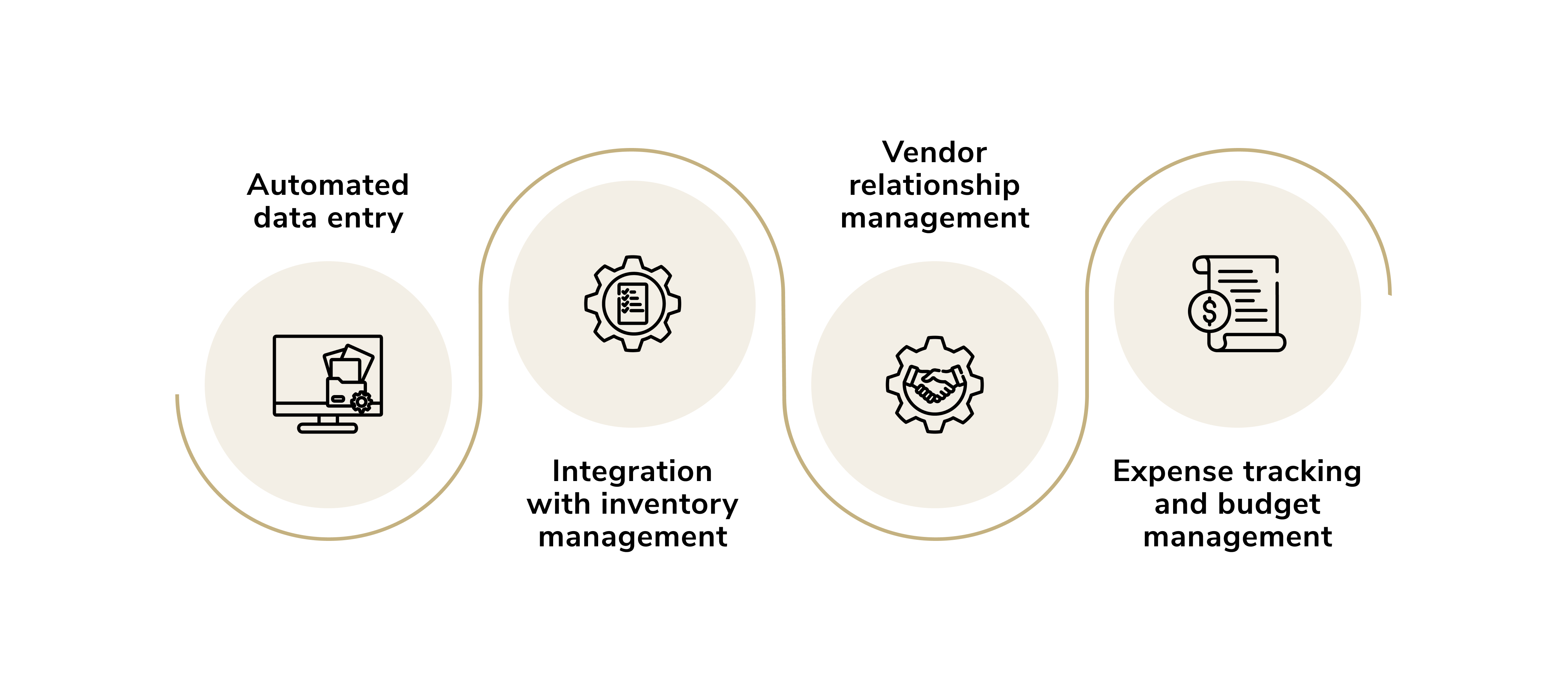
IBM leverages its AI capabilities through the Watson platform to enhance its procurement processes. By utilizing AI to analyze purchase order data, IBM can identify cost-saving opportunities and improve supplier negotiation strategies. The Watson system not only automates data processing but also provides insights that help forecast needs and manage supplier relationships effectively.
Expense Claims
Traditionally, the process of submitting, reviewing, and approving expense claims has been labor-intensive, often riddled with inefficiencies, errors, and delays. Utilizing Optical Character Recognition (OCR) and NLP, AI systems can automatically extract relevant information from receipts and invoices. This eliminates the need for manual data entry, reduces human error, and speeds up the claims process.
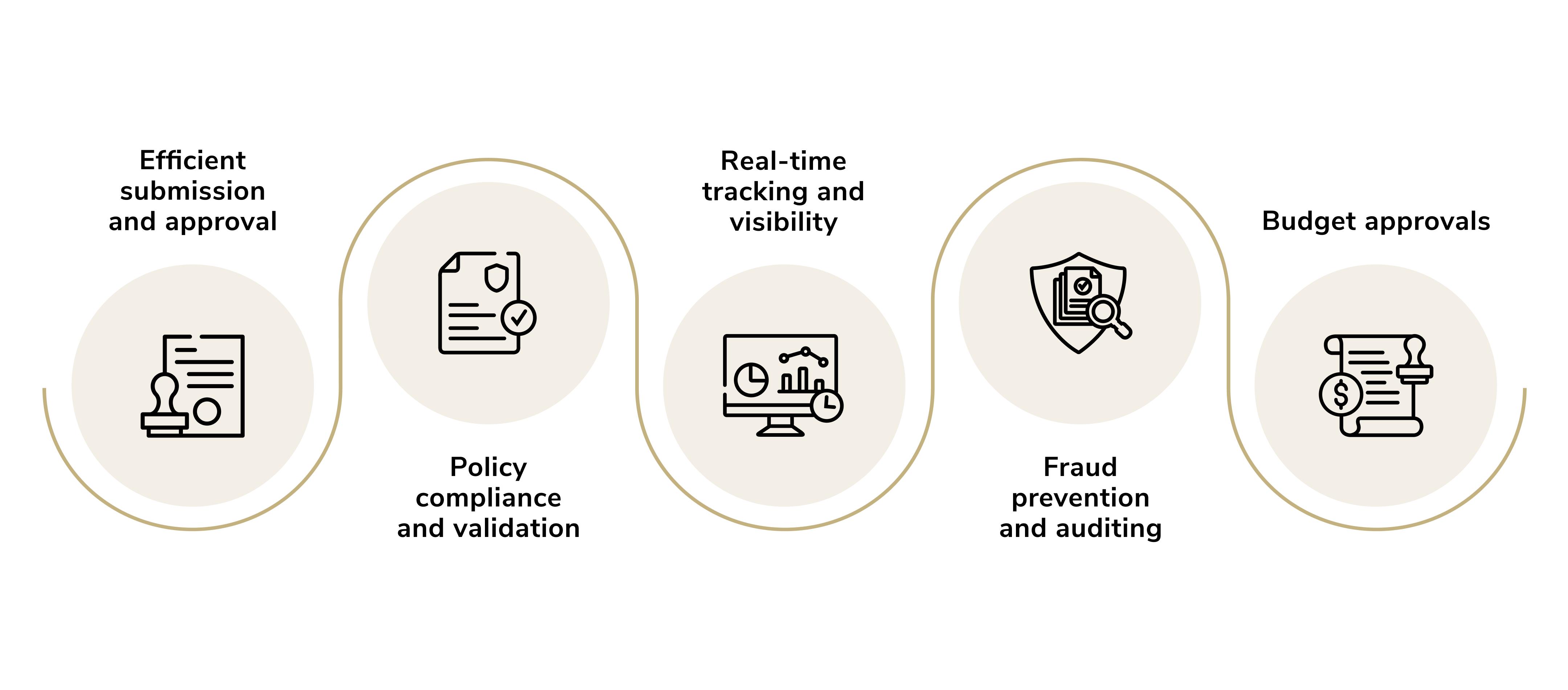
A prominent example of AI applied in expense claims automation is SAP Concur, a leading provider of travel and expense management solutions. SAP Concur utilizes advanced AI capabilities to optimize the entire expense management lifecycle for its clients. The platform employs machine learning to analyze past submissions, enabling it to automatically categorize expenses, suggest appropriate codes, and even flag unusual spending patterns that could indicate errors or potential fraud. For example, if an employee typically spends $50 on meals while traveling but submits a claim for $250, the system can flag this for review.
Customers using SAP Concur have reported substantial improvements in their expense management processes. For instance, organizations have noted reductions in processing time by as much as 50%, allowing finance teams to focus more on strategic initiatives rather than mundane administrative tasks. Moreover, real-time visibility into expenses empowers organizations to manage budgets more effectively and control spending habits.
Sales and Marketing
Sales teams often waste resources on low-quality leads or miss opportunities to engage at the optimal time. Traditional lead scoring methods rely on fixed criteria, which fail to account for the changing nature of customer behavior. By leveraging artificial intelligence, lead qualification becomes more accurate through the analysis of real-time engagement metrics, intent signals, and historical conversion trends.
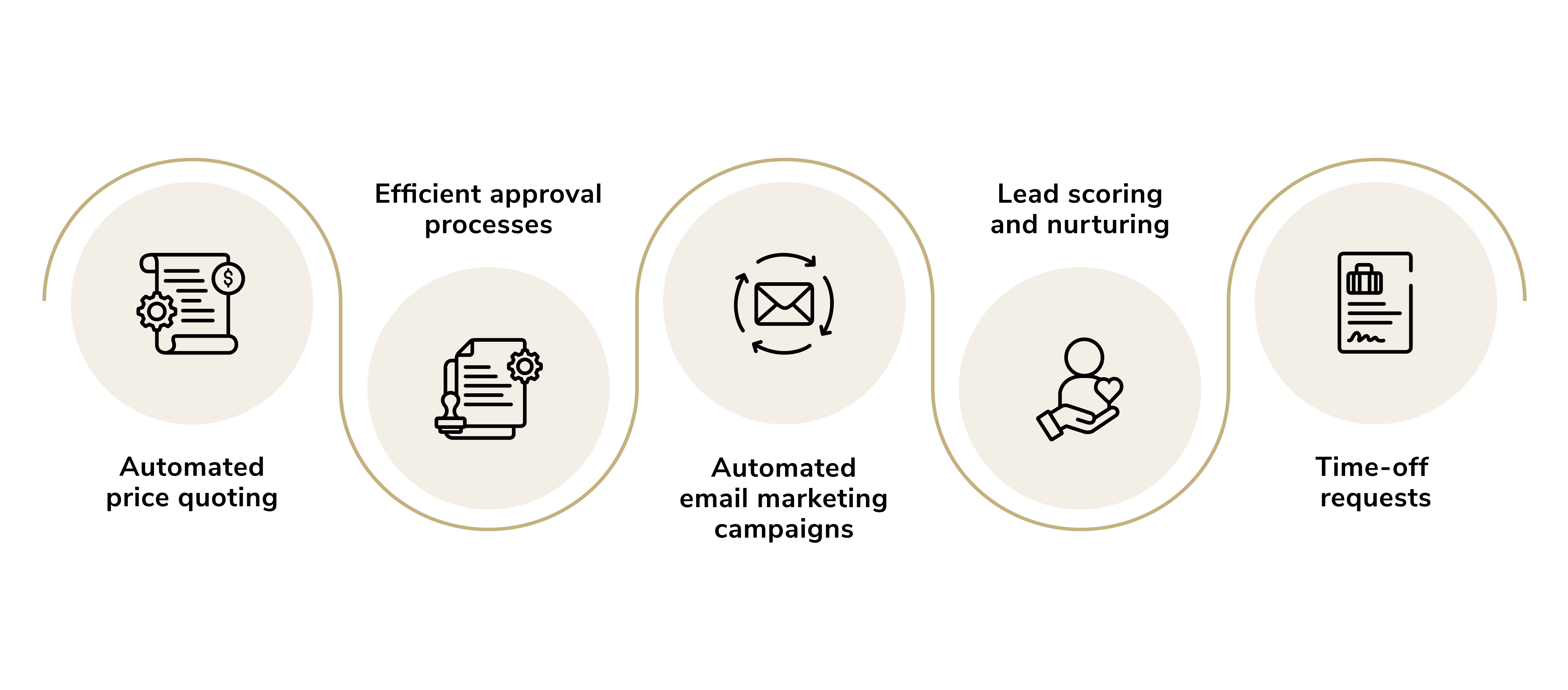
Coca-Cola harnessed the power of artificial intelligence and machine learning to streamline and elevate its marketing and sales efforts. By analyzing customer insights, AI facilitated personalized marketing initiatives, resulting in improved customer engagement and strengthened brand loyalty.
Additionally, machine learning improved sales forecasting and inventory management, ensuring efficient product availability. AI was also instrumental in automating content creation for marketing, allowing Coca-Cola to scale its strategies seamlessly. These advancements enhanced customer interactions and optimized sales performance.
Price Quotes
AI can significantly enhance the price quoting process through various mechanisms, including machine learning, NLP, and data analytics. AI algorithms can analyze vast amounts of historical pricing data, market trends, customer behavior, and competitor pricing. By leveraging this information, businesses can develop dynamic pricing strategies that automatically adjust quotes based on market conditions.
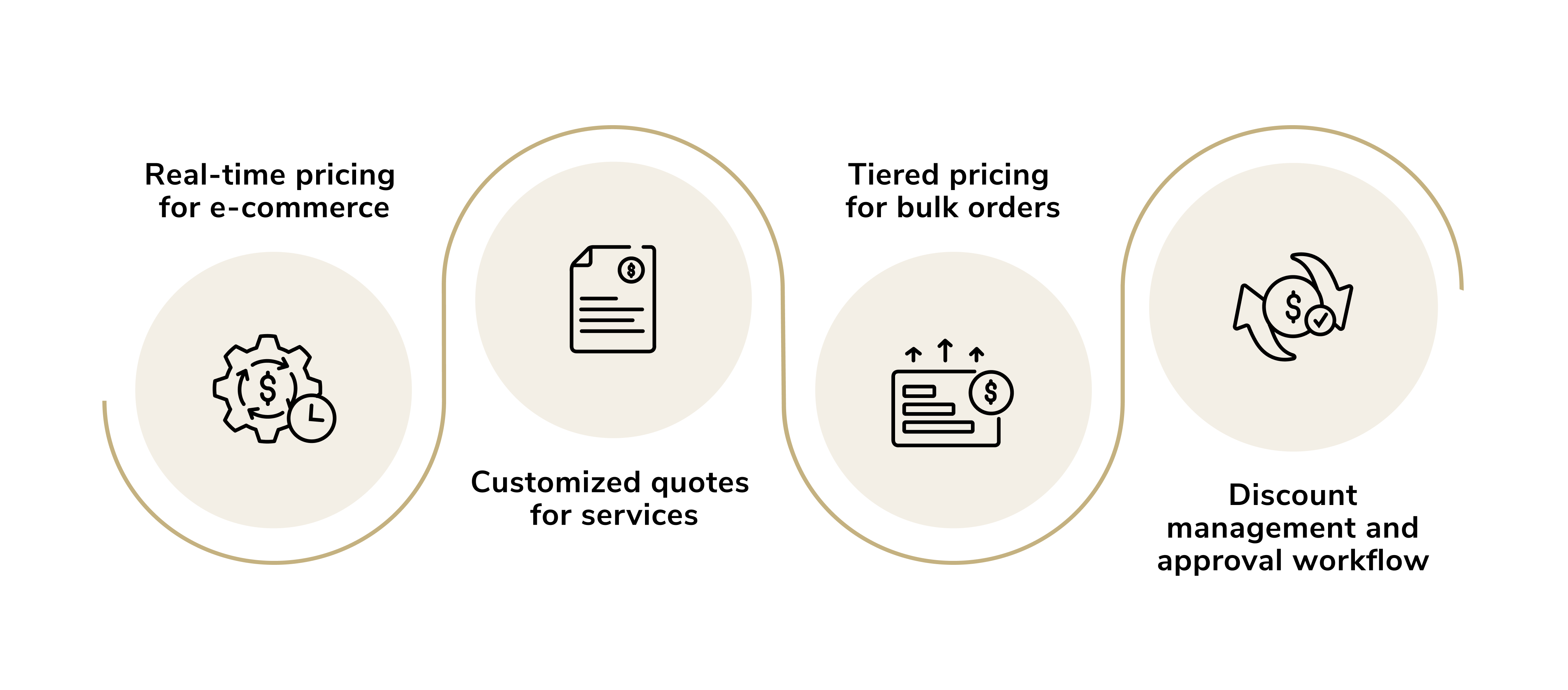
A notable example of a company leveraging AI for price quote automation is Zebra Technologies, a prominent provider of enterprise asset intelligence solutions. Zebra specializes in barcode and RFID technologies, offering a range of products that require precise and often complex pricing structures due to variations in features and customer requirements.
The company implemented an AI-driven pricing solution that integrates ML algorithms and data analytics to automate the quote generation process. Zebra thus reduced its quote generation time significantly. What previously took days, especially for customized solutions, now occurs in a fraction of the time, often within minutes. The automation minimizes human input, which traditionally introduced errors in pricing that could lead to lost sales or customer dissatisfaction.
Customer Service
Organizations that handle large volumes of customer interactions often face challenges like delayed responses, inconsistent resolutions, and inefficient ticket prioritization. AI-driven business process automation addresses these issues by analyzing ticket content and sentiment, recognizing intent, and automating responses to routine inquiries.
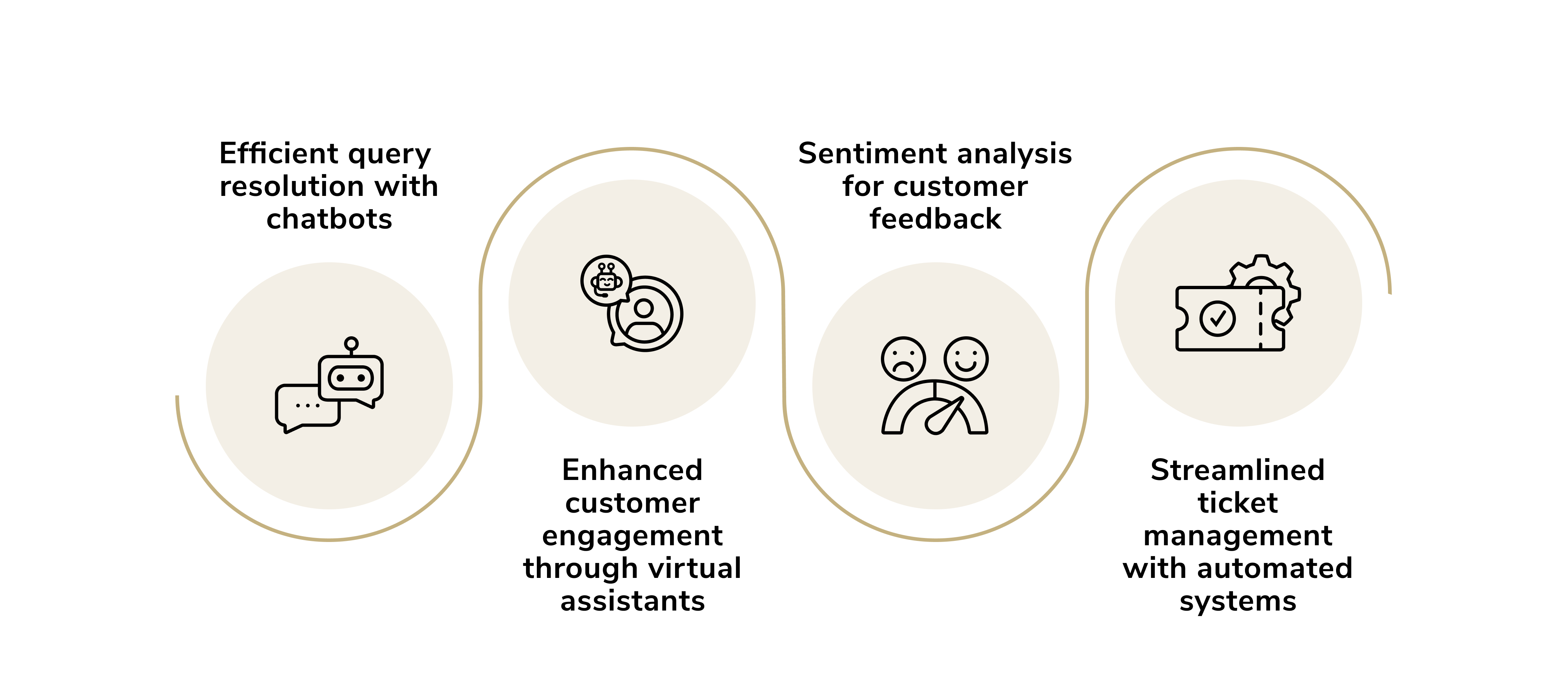
Telefonica, a prominent telecommunications company, implemented Amelia, an AI system developed by IPsoft, to automate customer service operations across various communication channels. Using advanced artificial intelligence and NLP, Amelia efficiently manages routine tasks like billing inquiries and technical support. This significantly reduces the need for direct human involvement.
The adoption of Amelia yielded remarkable outcomes for Telefonica, including:
- faster response times that improved customer experience
- substantial cost savings due to reduced reliance on manual processes
- higher customer satisfaction rates driven by consistent and accurate service.
Finance and Accounting
AI-driven business process automation is making a significant impact on finance and accounting operations. By automating tasks such as accounts payable, accounts receivable, and financial reporting, AI reduces the time and effort required to manage financial processes effectively. Furthermore, using AI for financial forecasting can help detect patterns in data and create strategic budgets.
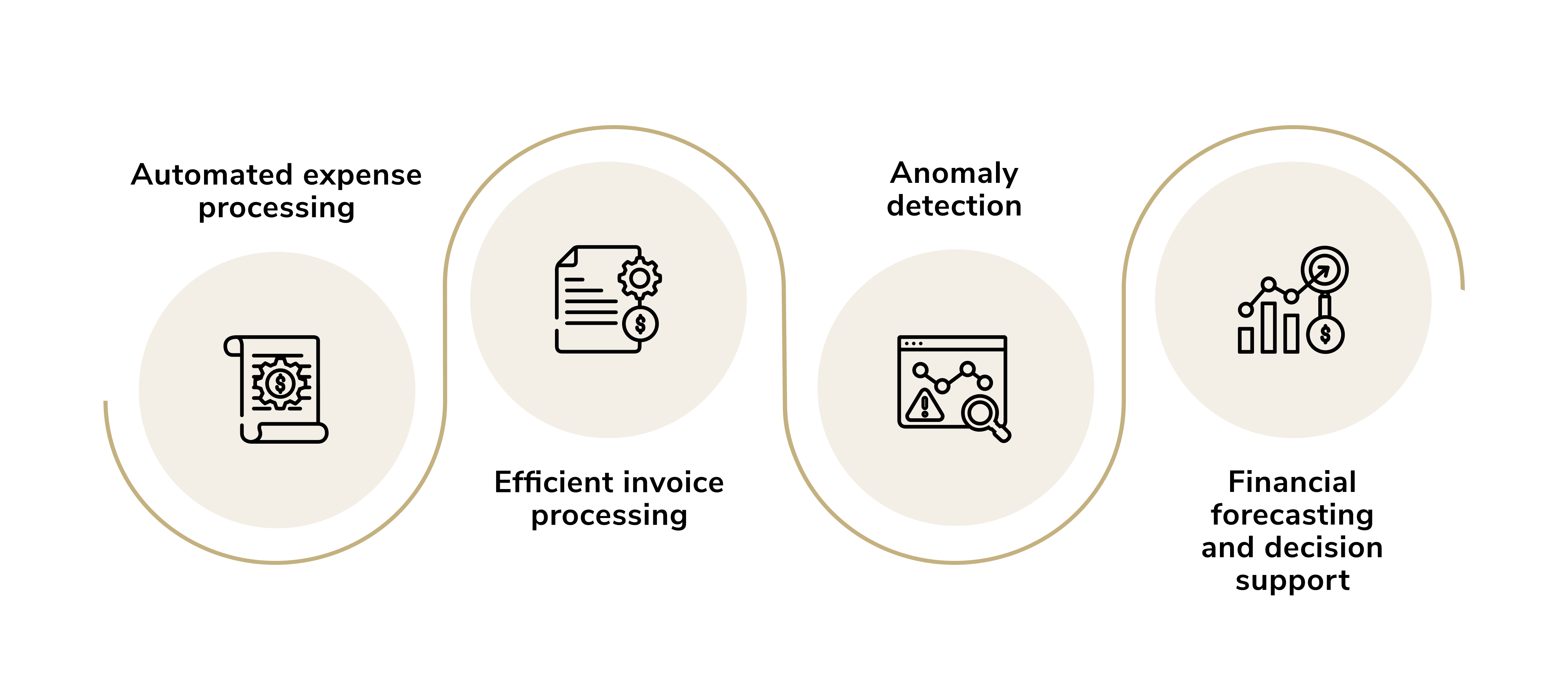
KPMG, a global leader in accounting and consulting, has adopted IBM Watson to enhance financial examinations. Leveraging artificial intelligence and natural language processing, Watson performs thorough analyses of agreements, financial statements, and other documents, identifying risks and ensuring compliance with regulatory standards.
This automation has improved the accuracy of audits while significantly reducing the time required for their completion. By streamlining data analysis, KPMG has minimized human errors and strengthened adherence to regulations. Additionally, this implementation has enabled the firm to focus more on high-value, strategic tasks, adding further value to their operations.
Cybersecurity
AI algorithms utilize machine learning to analyze vast amounts of data and recognize patterns indicative of potential threats. By continuously monitoring network traffic and user behavior, AI can identify anomalies that may signify a cyberattack, such as phishing attempts, malware infections, or unauthorized access.

One of the leading companies pioneering the use of AI for cybersecurity is Darktrace, a cybersecurity firm headquartered in Cambridge, UK. Founded in 2013, Darktrace has developed an advanced threat detection and response platform. It employs machine learning and AI algorithms to detect and respond to cyber threats in real time autonomously.
Darktrace's technology mimics the human immune system, learning the unique "pattern of life" for every user and device within an organization's network. By establishing these behavioral baselines, Darktrace's AI can detect anomalies indicative of potential threats, often before any damage occurs.
Through a feature called "Antigena," Darktrace can take automated actions in response to threats. For example, if it identifies abnormal behavior that suggests a ransomware attack, Antigena can instantly quarantine affected systems or limit user access, effectively neutralizing the threat without waiting for human intervention.
Legal
One of the most resource-intensive tasks in legal practice is document review, particularly during the discovery phase of litigation. Manual review is commonly limited in scope, reactive in nature, and difficult to scale effectively. AI can analyze vast volumes of documents rapidly. The system can identify relevant documents, categorize them, and even flag those that are privileged or confidential.
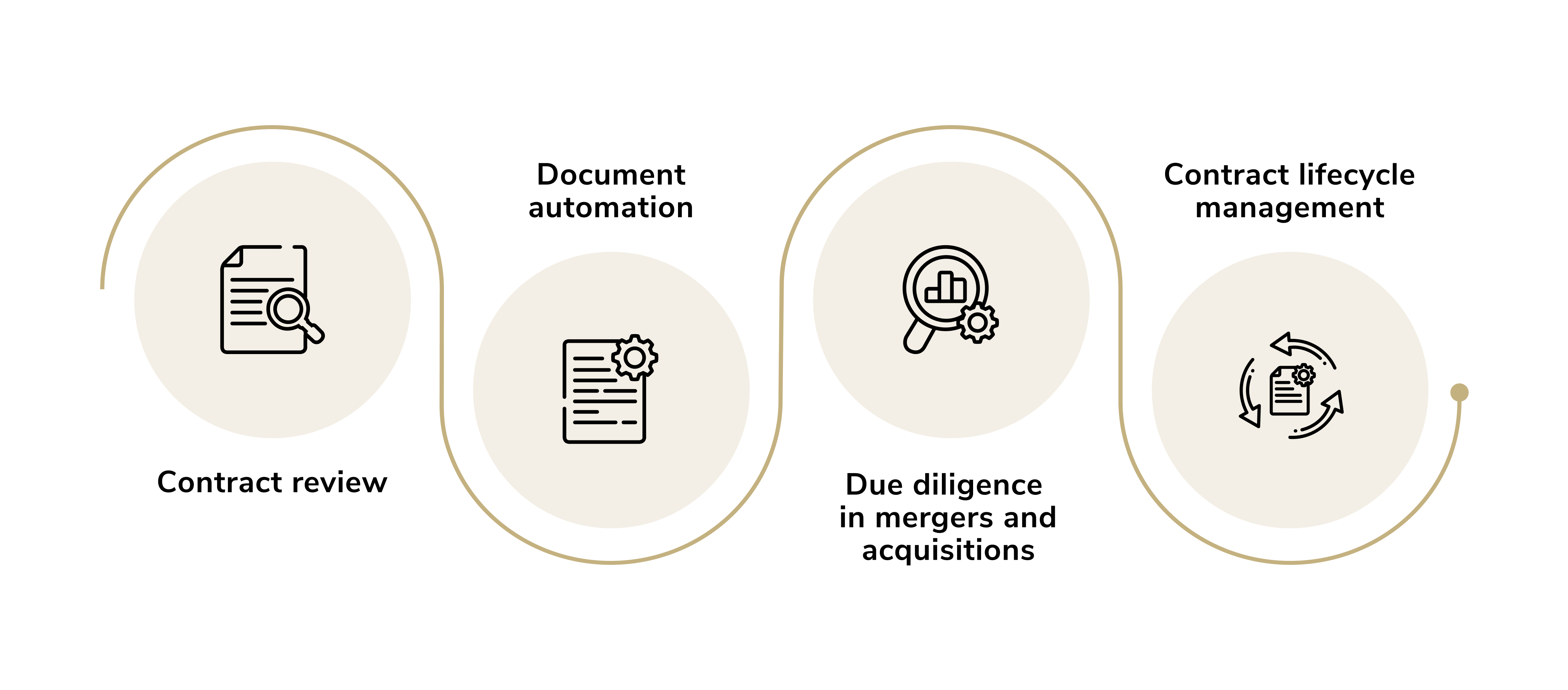
A notable example of a company leveraging AI for legal process automation is Kira Systems, a Toronto-based AI software provider. Kira specializes in contract analysis and document review. Its AI-powered platform employs machine learning to extract and analyze important information from contracts and other legal documents.
Kira's machine learning models have been trained on thousands of legal documents, allowing the software to recognize and extract clauses, terms, and key provisions with remarkable accuracy. By automating the document review process, Kira helps law firms and in-house legal teams significantly reduce the time required for due diligence, mergers and acquisitions, and compliance audits.
The Biggest Challenges in Adopting AI
Research by McKinsey sheds light on the primary obstacles businesses face when adopting AI, applicable to both AI high performers and companies still in the early stages of their AI journeys. Even organizations labeled as high performers in AI experience notable difficulties in deriving consistent value from their AI initiatives. These challenges often stem from the complex nature of their advanced AI maturity. Operational hurdles, such as effectively monitoring and periodically retraining AI models, remain significant issues for these companies.
On the other hand, businesses at a foundational level encounter more fundamental challenges. These include establishing a clear AI strategy aligned with business goals or securing sufficient financial and technical resources for AI implementation. Deciding whether to outsource AI development or do it in-house is a pivotal choice that can greatly influence the results. The scarcity of skilled talent, coupled with the growing demand for Python developers, makes finding the right expert a daunting challenge. Meanwhile, training in-house employees requires substantial time and financial resources. For many organizations, outsourcing AI development offers a more practical and cost-effective solution, enabling them to harness expertise without overextending internal resources.
Notably, the findings reveal that even high performers have yet to fully adopt and master AI best practices, such as MLOps (Machine Learning Operations). However, they appear to be further along the path compared to companies still grappling with basic alignment and resource acquisition challenges.
Recognizing and Addressing the Risks of Generative AI
As organizations increasingly adopt AI, they are also contending with a range of associated generative AI challenges. These risks can be categorized primarily into three areas:
- Data management: concerns include data privacy issues, potential biases, and violations of intellectual property (IP) rights.
- Model management: this pertains to challenges like generating inaccurate outputs and the lack of explainability in AI models.
- Security and misuse: risks such as cybersecurity vulnerabilities and improper application of the technology.
Of all the identified risks, inaccuracy stands out as the one businesses are most proactively addressing. This issue impacts multiple applications across the generative AI value chain, including
- customer interactions
- content summarization
- software coding
- creative outputs.
To imagine the real-world implications, consider this: 44% of survey respondents acknowledged that their organizations have already encountered at least one negative consequence stemming from the use of generative AI. Among these, inaccurate output is the most commonly reported issue, followed by concerns about cybersecurity and the inability to explain how the AI generates results.
How to Use AI for Business
Reflecting on the past several years of market dynamics, one thing we are sure of is that businesses should resist adopting technology purely for its novelty. One of the most important lessons learned is the necessity of aligning generative AI applications with core business goals. Companies should aim to identify key business opportunities and strategies first, then map them to potential generative AI use cases. The highest-performing organizations are those leveraging gen AI to rethink and redesign entire workflows and processes, rather than merely integrating the technology into existing systems.
Taking a bold and visionary approach to workflow transformation often yields the most significant benefits.
For these transformation efforts to succeed, leaders need to prioritize change management throughout the implementation process. They should anticipate continuous change as organizations build gen AI infrastructures that are both scalable and cost-effective over the long term. Creating value from gen AI requires cross-departmental collaboration, with guidance from leaders in HR, finance, legal, and risk management. These functions must work closely to refine resource allocation and align productivity expectations, ensuring the initiative delivers measurable bottom-line impact.
Furthermore, responsible AI must be prioritized from the outset. At its core, it begins with a company's foundational values. Organizations need to establish explicit principles for how gen AI is applied and create safeguards for its responsible use. For instance, ensuring robust data security involves keeping company-level data and prompts strictly within enterprise boundaries. To achieve this, enterprises must establish secure agreements with LLM providers and application vendors. Comprehensive training is also necessary to help employees distinguish between enterprise-grade tools and public tools, preventing inadvertent exposure of proprietary data or code to public models.
How to Automate Your Business
Integrating AI automation into your organization can lead to significant benefits, but its success depends on thorough planning and execution. Below are five actionable steps to help businesses successfully adopt AI in their workflows.
Step 1. Identify Suitable Processes and Metrics for Success
Not all business processes benefit equally from AI. Focus on those with
- high transaction volumes
- significant decision variability
- manual interventions
- rich historical data.
Instead of addressing isolated inefficiencies, analyze processes in their broader business context. This involves charting interdependencies, tracking data flows from upstream to downstream, and defining key performance indicators (KPIs) tied to desired outcomes.
Step 2. Align AI Systems with Business Operations
One of the main challenges in AI-driven BPA is ensuring that model outputs seamlessly integrate with real-world business logic. AI systems must reflect operational guidelines, manage exceptions, and account for process-specific nuances. For the best outcome, embed domain expertise into AI workflows through feature engineering, designing constraints, and applying post-processing rules. When necessary, utilize hybrid architectures that combine statistical learning models with deterministic rule engines to ensure accuracy and alignment.
Step 3. Conduct Proofs of Concept (PoCs) in Controlled Settings
An oft-seen mistake in AI-driven BPA is deploying complex models without adequate validation. To mitigate risks, start with targeted Proofs of Concept (PoCs) in controlled environments built around well-defined use cases. Their purpose is to confirm the feasibility and value of AI models, validate their robustness, and address uncertainties early in the process.
Note: Proofs of concept play a critical role in determining the practicality of AI use cases; however, many fail to progress beyond the initial testing stage. The problem typically lies not with the model itself but with the absence of production-ready infrastructure, comprehensive integration plans, and collaboration with operational teams. To ensure the success of an AI proof of concept, it must be structured with a clear roadmap to production. This includes defining technical, business, and process ownership rights from the start.
Step 4. Build Holistic AI Teams
Build cross-functional delivery teams that integrate data scientists, machine learning engineers, process owners, business analysts, and system architects. These teams should operate according to your agile transformation roadmap to maintain alignment between technical solutions and business objectives. Furthermore, foster AI literacy within your organization, enabling key stakeholders to interpret AI outcomes, evaluate trade-offs effectively, and establish clear governance guidelines.
Step 5. Manage the AI Lifecycle
Sustaining AI in BPA requires a robust lifecycle management framework. Develop scalable MLOps systems to address model version control, retraining, drift detection, performance monitoring, and governance. Ensure that training and inference data pipelines operate efficiently at production scale and integrate seamlessly with existing business systems. Whether AI deployment occurs on cloud platforms, on-premise infrastructures, or hybrid systems, you should ensure alignment with IT policies, security protocols, and scalability demands.

Roman Zomko
Other articles